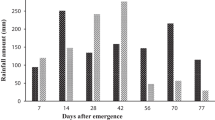Abstract
As the surface area with late blight symptoms of seed tubers increased, the incidence of plant emergence decreased. This relationship was more dramatic with the US-8 genotype than the US-1 genotype ofhytophthora infestans, causal agent of late blight. However, when seed tubers were inoculated with both US-1 and US-8 isolates, the plant growth responses were generally intermediate to those obtained with the two genotypes alone. More resistant cultivars (eg. Dorita, Island Sunshine, and Sebago) had greater plant emergence and less seed rot than more susceptible cultivars (eg. Green Mountain and Shepody) but the response differences between resistant and susceptible cultivars was less clear with US-8 as most cultivars had 100% seed rot. Seed handling treatments affected crop growth and disease risk; as the inoculum levels and in some cases, the pre-planting storage period increased, plant emergence decreased generally due to greater seed rot incidences. Of the one registered seed treatment fungicide and several non-registered and/or experimental fungicides tested, only two significantly improved plant emergence.
During three years of study, “diseased” seed treatments generally led to seed rot except in 1996 when one plant in one experimental plot of infected seed had subsequent spread of the disease to the foliage. Furthermore, within one week, a field epidemic developed outwardly from the single infected plant due to the occurrence of favourable weather conditions. Further research opportunities are discussed relative to the impact of infected seed on crop growth and disease risk
Similar content being viewed by others
Literature Cited
Deahl, K.L., R.W. Goth, R. Young, S.L. Sinden, and M.E. Gallegly. 1991. Occurrence of the A2 mating type ofPhytophthora infestans in potato fields in the United States and Canada. Am Potato J 68:717–725.
Deahl, K.L., D.A. Inglis, and S.P. DeMuth. 1993. Testing for resistance to metalaxyl inPhytophthora infestans isolates from northwestern Washington. Am Potato J 70:779–795.
Fry, W.E., S.B. Goodwin, A.T. Dyer, J.M. Matuszak, A. Drenth, P.W. Tooley, L.S. Sujkowski, Y.J. Koh, B.A. Cohen, L.J. Spielman, K.L. Deahl, D.A. Inglis, and KP. Sandlan. 1993. Historical and recent migrations ofPhytophthora infestans: Chronology, pathways, and implications. Plant Dis 77:653–661.
Fry, W.E., S.B. Goodwin, J.M. Matuszak, L.J. Spielman, M.G. Milgroom, and A. Drenth. 1992. Population genetics and intercontinental migrations ofPhytophthora infestans. Annual Rev Phytopathol 30:107–129.
Goodwin, S.B., B.A. Cohen, K.L. Deahl, and W.E. Fry. 1994. Migration from northern Mexico as the probable cause of recent genetic changes in populations ofPhytophthora infestans in the United States and Canada. Phytopathology 84:553–558.
Goodwin, S.B., R.E. Schneider, and W.E. Fry. 1995a. Use of cellulose-acetate electrophoresis for rapid identification of allozyme genotypes ofPhytophthora infestans. Plant Dis 79:1181–1185.
Goodwin, S.B., L.S. Sujkowski, A.T. Dyer, B.A. Fry, and W.E. Fry. 1995b. Direct detection of gene flow and probable sexual reproduction ofPhytophthora infestans in northern North America. Phytopathology 85:473–479.
Johnson, D.A., T.F. Cummings, P.B. Hamm, R.C. Rowe, J.S. Miller, R.E. Thornton, G.Q. Pelter, and E.J. Sorensen. 1997. Potato late blight in the Columbia Basin: An economic analysis of the 1995 epidemic. Plant Dis 81:103–106.
Lambert, D.H. and A.I. Currier. 1997. Differences in tuber rot development for North American clones ofPhytophthora infestans. Am Potato J 74:39–43.
Peters, R.D., H.W. (Bud) Platt, R. Hall, B. Matheson, and L. McNally-Shanahan. 1996. Characterization of isolates ofPhytophthora infestans from Canada according to mating type and sensitivity to metalaxyl. (Abstr) Can J Plant Pathol 18:97.
Peters, R.D., H.W. (Bud) Platt, and R. Hall. 1998. Characterization of evolving populations ofPhytophthora infestans in Canada using mating type and metalaxyl sensitivity markers. Can J Plant Pathol (in press).
Platt, H.W. (Bud). 1994. Response of potato breeding program advanced selections and potato cultivars to late blight, 1992. APS Biol & Cult Tests 9: 62.
Van der Zaag, D.E. 1956. Overwintering en epidemiologie vanPhytophthora infestans tevens enige niewe bestrijdingsmogelijkheden. Tijdschrift Over Plantenziekten 62:89–156.
Author information
Authors and Affiliations
Corresponding author
Rights and permissions
About this article
Cite this article
Platt, H.W.(., Peters, R.D., Medina, M. et al. Impact of seed potatoes infected withPhytophthora infestans (US-1 or US-8 genotypes) on crop growth and disease risk. Amer J of Potato Res 76, 67–73 (1999). https://doi.org/10.1007/BF02855202
Accepted:
Issue Date:
DOI: https://doi.org/10.1007/BF02855202




